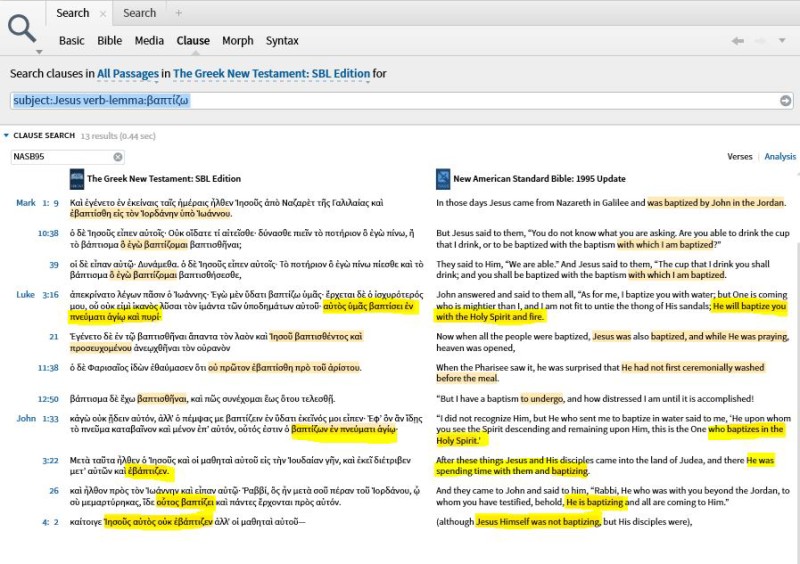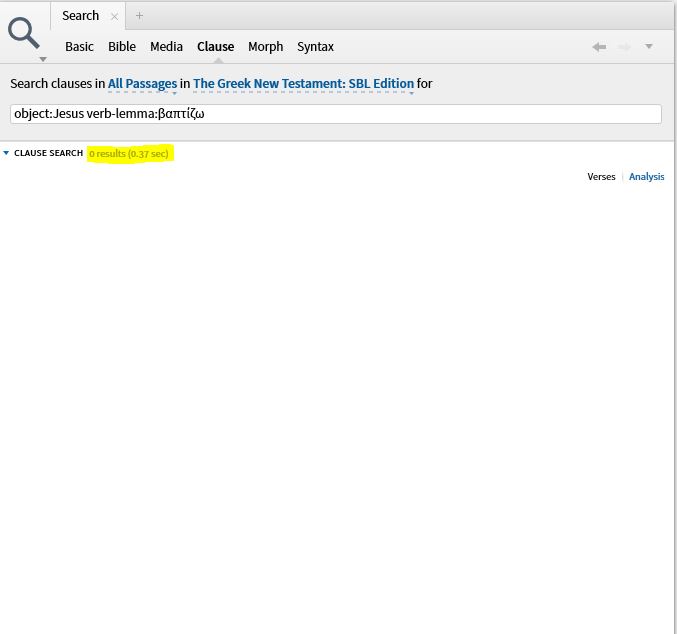Last week I wrote a post about exploring meaning using case frames in Logos 6. I plan to come back to that topic with more practical examples in the near future, but I also wanted to introduce you to the semantic roles data on its own terms by taking a look at how these roles have enhanced clause search. By the end of this post, I think you will agree with me that this dataset is, quite frankly, awesome.
First, a brief aside: the case frame data that I talked about in the last post is made up of the semantic roles data. The important point here is that you can approach this data by looking at case frames as units of analysis or by individual semantic roles as units of analysis. If that doesn’t make sense at this stage, it’s not so important, but it may help to know that the case frames and semantic roles are interrelated.
Now I will inductively work through an example that I think will demonstrate just how exciting this new feature is. Imagine for a moment that we want to find all of the places in the Bible that talk about Jesus being baptized. In the past, we might have tried to accomplish this by using clause search and the grammatical categories of ‘subject’ and ‘object.’
First, we might think: John the Baptist (subject) baptized Jesus (object). So, our first search might be something like “object:Jesus verb-lemma:βαπτίζω.” Let’s check out the results of this search:
Nothing.
What’s the issue? … We forgot to take into account the passive voice. Maybe all of the cases of Jesus being baptized are more like: Jesus (subject) was baptized by John. Our next search might end up as “subject:Jesus verb-lemma:βαπτίζω.” Here’s what we would find:

This is obviously better; however, we’ve still got some noise in our search. We’re seeing instances that mention Jesus actually doing the baptizing. Is there a better way to do this?
If we think briefly about the semantic roles for βαπτιζω, it is possible to find a better way. A look at the semantic roles for βαπτιζω tells us that the person being baptized in each case is a “Theme.” With that little bit of knowledge, it is possible to search by meaning (i.e., semantics), as opposed to grammatical categories like subject and object that don’t always overlap completely with meaning.
If the previous paragraph was too much to parse, don’t worry about it because I think the next example search will make it easier to understand. What if we were to try “theme:Jesus verb-lemma:βαπτίζω”? Here’s what we would find:
Jackpot! Take a look at the results. Now we’re seeing exactly what we want. But wait … there’s more. What if on the other hand, we wanted to find all of the places that mention Jesus doing the baptizing (for example, baptizing with the Holy Spirit)? Another brief reflection on the semantic roles of βαπτιζω would tell us that the person doing the baptizing is an “Agent.” Maybe we could try “agent:Jesus verb-lemma:βαπτίζω”:
Bingo! Our ability to search the Bible becomes so much more powerful when we are searching by meaning as opposed to searching by grammatical categories. I hope that this example has demonstrated that it is worth the time to get to know the semantic roles data because it could save you a lot of time in the long run.
So, go buy Logos 6 if you haven’t already! Then feel free to ask any questions about semantic roles here or in the Logos forums. Or, drop a cool example of how you’re using this tool in the comments below.



One response to “Searching Semantic Roles is Awesome in Logos 6 #Logos6”
Jeremy, I only begin to grasp all the various ways I could use this (semantic roles+case frames) and I already think what a wonderful tool this is!
I praise God for your great work on Hebrew OT concerning this sort of tagging – big thanks to you and your whole team!